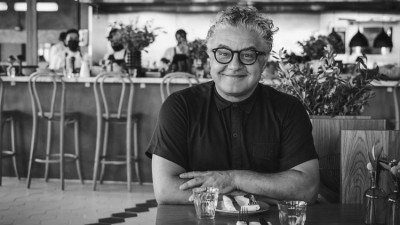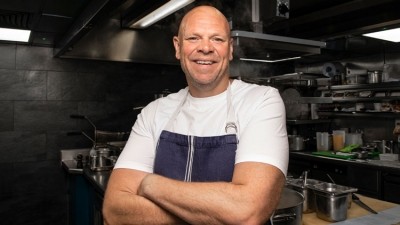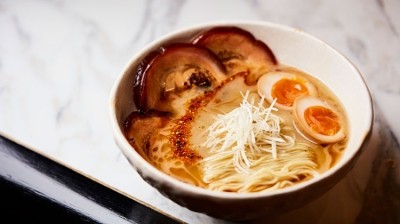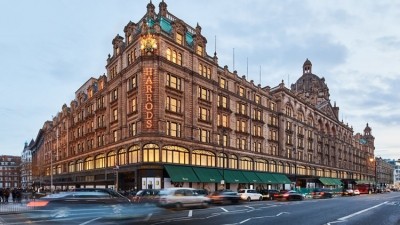The department store gunning to become the capital’s premier dining destination
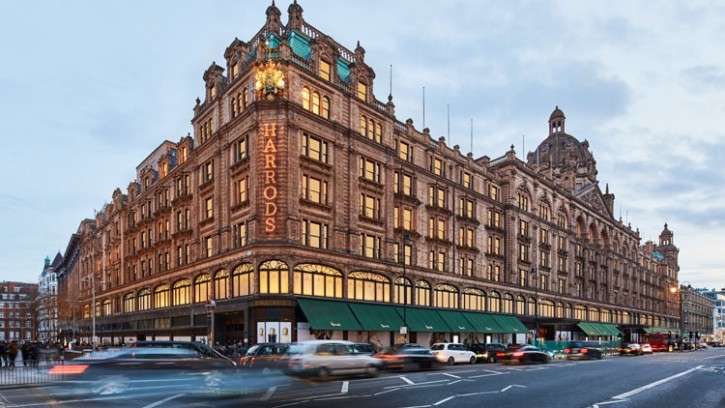
When Ashley Saxton first arrived at Harrods bosses at the world-famous department store were closing restaurants to put in more retail space. It’s now the other way round, with space for fashion, homeware and beauty services being scaled back to accommodate more F&B.
Joining Harrods in 2019, Saxton has overseen a step change in the Knightsbridge store’s approach to restaurants. Prior to his arrival the F&B at Harrods’ flagship location was for the most part not in line with the brand’s status as one of the globe’s foremost luxury retailers. Yet he and his higher ups suspected the store’s moneyed, often international customer base was looking for something much more aspirational to complement their Hermès handbags, Cartier watches and Christian Louboutin heels. They were right.
Now director for restaurants and kitchens, Saxton’s key innovation has been to bring in brands with a powerful pull to lend their names to F&B, whether that be iconic fashion houses like Prada or heavy-hitting chefs. Harrods boasts that it has more Michelin-starred chefs in situ than anywhere else in Europe. While none of its restaurants currently hold stars themselves, the Brompton Road store is home to Gordon Ramsay, Jason Atherton, Tom Kerridge and Björn Frantzén.
The shake-up of the store’s restaurant and wider F&B operation was disrupted by the pandemic, but the period of enforced closure also helped things along by allowing Harrods to clear out dead wood and develop new concepts.
“Covid was terrible, but it did allow us a reset,” says Saxton. “We ended up closing a lot of restaurants because we knew they weren’t going to be right for us in the long term. As we emerged from the pandemic we launched a lot of restaurants at a time when most operators were battening down the hatches. One week it was Jason Atherton, the next it was Tom Kerridge.”
A bold approach underpinned by heavy investment and a willingness to take a long-term view – Harrods is owned by the State of Qatar via its sovereign wealth fund - is now paying dividends. Today, some 21% of visitors to Harrods visit a restaurant within the store compared with only 8% in 2019.
The F&B trading figures are equally impressive. Last year, restaurant trade was up 44% on any other year and 2023 is shaping up to be even better with turnover already up 36% on 2022. This mirrors that of the wider operation, with the store recently reporting profits of £171.6m and a sales increase of 52% to £994m in the year to January 2023, according to accounts filed at Companies House.
Spoilt for choice
Harrods’ F&B operation is huge. Its Dining Hall area is currently closed pending a high-profile relaunch set early next month (more on this later) and when it’s back up and running the store will have around 20 separate offers.
While none of them are likely to make any cheap eats listicles, Harrods does offer a surprisingly wide spread of price points and dining styles ranging from relatively affordable options like Harrods Café and casual Italian restaurant Pizzeria & Pasqua to unashamedly luxe affairs including the Baccarat Bar, Studio Frantzén and Kerridge’s Fish & Chips (the latter was recently forced to defend the £35 price tag of its principal dish).
The restaurants are there to generate revenue, but they also play a critical role in driving footfall, according to Saxton. “We know from our insights that if a customer touches a restaurant – from a coffee and a piece of cake right through to a three-course meal – they visit the store more often, spend twice as long in the building and spend more money.”
As well as making the restaurants more aspirational and more international in flavour, the positioning of F&B throughout the store has been rethought. Rather than being siloed off into one or two areas – as is the case with many venues that combine retail and hospitality – Harrods’ F&B is now more closely integrated with retail.
A prime example of this is the Champagne Bar. Champagne and beauty go hand-in-freshly-manicured-hand, yet in its previous incarnation the Champagne Bar was located on the other side of the building to the beauty department. To address this, the recently launched Moët & Chandon Champagne Bar is in the middle of the beauty department, with guests now perched within arm’s reach of compacts and lipsticks.
“We now have a Champagne bar that is 50% less in terms of square foot than the previous one but is driving 18% more trade,” says Saxton, who has also overseen the introduction of bookings, which surprisingly weren’t a thing at Harrods prior to his arrival. Now most restaurants are bookable, with more than 7,000 bookings taken each week.
Humble origins
Saxton joined Harrods in 2018 from international luxury hotel group Langham Hospitality. As one would expect, he has a CV that demonstrates a strong track record in delivering high-end F&B projects and also a first-hand understanding of the international markets most relevant to Harrods having spent much of his career in the Middle East and Asia (he was part of the launch team for Dubai’s lavish marine-themed resort Atlantis, The Palm, for example).
Yet his background is far removed from luxury hospitality, having started his career aged 14 washing dishes at an unremarkable hotel just outside Nottingham. “My family background is more about hard graft than education,” he says. “Being on the potwash was not aspirational. But I liked it because people treated me like an adult.”
The hotel’s restaurant held three AA rosettes and was staffed by a strong team. A few weeks in, a sous chef saw something in Saxton and set him on the path to becoming a chef but not long after that he switched to front of house. He worked his way up the ladder in several UK hotels and conference centres before heading to Dubai in the late 2010s just as the hospitality scene there was exploding.
Twenty or so years into his career, Saxton now leads a team of 900 including around 350 chefs. He heads an executive team of five - one overseeing culinary, one operations, one business development, one project execution and one overseeing the F&B side of Harrods’ international arm.
Changing things up in the Dining Hall
Saxton and his team’s most pressing project is the overhaul of the store’s ornate Dining Hall, which is set to reopen to the public on 7 October. The space was relaunched as the Dining Hall in 2019 having previously been more geared towards the takeaway market.
The overarching concept and look of the area will be similar – a decidedly high-end food hall with six options – but Saxton is doubling down by throwing four high-profile international chefs into the mix, of which the headline act is master sushi chef Masayoshi ‘Masa’ Takayama. Taking pride of place in the middle of the space, Sushi by Masa will be the first restaurant outside the US for the chef, whose Masa restaurant in New York holds three Michelin stars.
Sushi by Masa will trade alongside Neha Mishra’s Kinoya Ramen Bar, Athanasios Kargatzidis’ Greek concept Assembly Mezze & Skewers, and Pasta Evangelists. The latter was part of the first tranche of operators at the Dining Hall but will reopen under the direction of Italian chef Giancarlo Perbellini, whose Casa Perbellini restaurant in Verona holds two Michelin stars. Kerridge’s Fish & Chips and The Grill will remain but are undergoing some tweaks.
The changes are part of a concerted push to re-establish the Dining Hall – and the department store more generally – as a night-time dining destination. “The Dining Hall has been a big success. It does an average of 1,400 covers a day,” Saxton says. “The issue is that it is not that successful at night-time. Clearly dinner is a much bigger prize in this industry than lunch, so to be seen as a global leader in hospitality we need to make it work too.”
It is hoped that the pull of these international chefs combined with a live music programme – a stage is currently being erected in the middle of the room – and a social media campaign will significantly increase evening covers.
“It’s a high stakes project,” Saxton continues. “Opening a restaurant is hard enough, but trying to get six different ones open on the same day is another level of challenge. But we’re in a good place; we have been planning this for 18 months.”
There are three operating models within Harrods’ F&B portfolio. First, concepts that are conceived and operated by Harrods itself. Second, concepts operated by Harrods on a licenced basis and – finally – what Harrods calls concessions which, though still partnerships of sorts, see the store effectively lease space to an operator. All three models can be found in the Dining Hall with The Grill one of Harrods’ own concepts, Sushi by Masa run under a licence agreement and Kinoya Ramen Bar a concession that will be staffed and operated by a team employed by the restaurant’s creator rather than Harrods.
Crunching data
Harrods’ enviable customer data informs the F&B selection process to some extent, with most transactions at the store made using its reward card. As a result, Harrods can track a customer’s journey through the store and see what they are buying and how many times they are visiting.
“It might be that there is a particular type of customer we are looking to attract to a particular part of the store. We then start thinking about cuisine and who is doing it best. Brand recognition is important, too, and that is often dependent on where people are from in the world. They need to recognise the brand, not just the cuisine,” says Saxton, who tends to borrow from the play book of major casinos and resorts rather than retail or hotels.
“[Casinos] are the originators of this. They have been using hospitality to drive their overall business for decades. Hotels have been a little late to the party, but they are now starting to understand F&B in a very different way.”
Saxton is also responsible for Harrods’ “small but growing” international F&B operation. All in-house owned and operated, these include five Champagne bars, two restaurants in Qatar and a private members club and a tearoom in Shanghai. Following the pandemic-related closure of much of its overseas retail business (the only sites that remain are airport concessions) these ventures are a vital shop window for the group, with at least a dozen further overseas ventures currently in the works.
Looking to the future
The short-term F&B plans are impressive, but there’s much more in the works. After the relaunch of the Dining Hall, the attention will be turned to the fourth floor. First up is a comprehensive overhaul of The Harrods Tearooms, which launched some 120 years ago as The Georgian in a different location within the store.
The Harrods Tearooms is expected to close in April next year and reopen the following October as The Georgian having been “brought back to life” by David Collins Studio with a design and F&B concept that will explore the history of afternoon tea. Saxton hints that the revitalised The Georgian could well become a blueprint for Harrods tearooms overseas.
“Harrods started out as a tea merchant. Afternoon tea is something we must have ownership of. It is our aim to offer the best afternoon tea, not just in the UK but globally. We do an amazing afternoon tea already, but we can do it better.”
Not long afterwards in either Q1 or Q2 2025, the store will once again throw down the gauntlet in terms of international chefs with the concurrent launch of four restaurants that will replace Angela Musa’s patisserie, The Levant Bakery and Dim Sum Terrace pop-up. The only restaurants to remain will be Gordon Ramsay Burger and The Harrods Tearooms.
One of them will be an outpost of Singaporean-born modern Australian barbecue concept Burnt Ends. Announced earlier year, the signing is a major coup for Harrods with chef Dave Pynt’s flagship currently ranked 34 on The World’s 50 Best Restaurants list.
The other three are yet to be announced, but the confident way in which Saxton talks about the changes on the fourth floor suggests they are locked in. Each will mark the UK debut of an international chef with “multiple Michelin stars”, thus cementing Harrods’ status as London’s premier destination for high-end international dining.
“I’ve opened about 60 restaurants in my time including at least 20 permanent restaurants at Harrods,” he says. “But this is the launch that I’m really excited about.”





